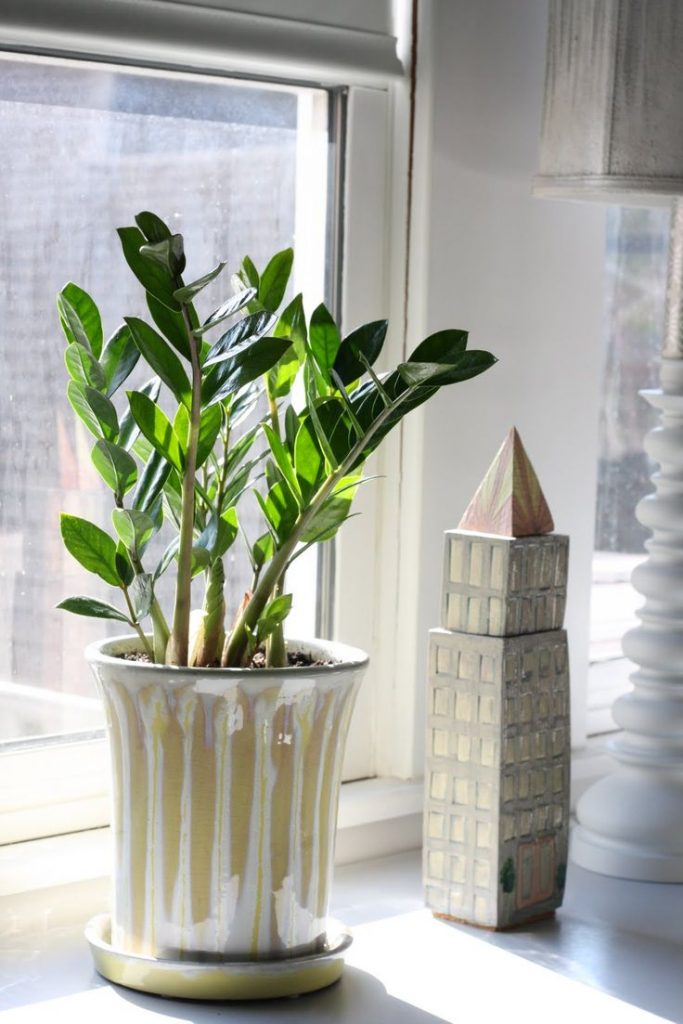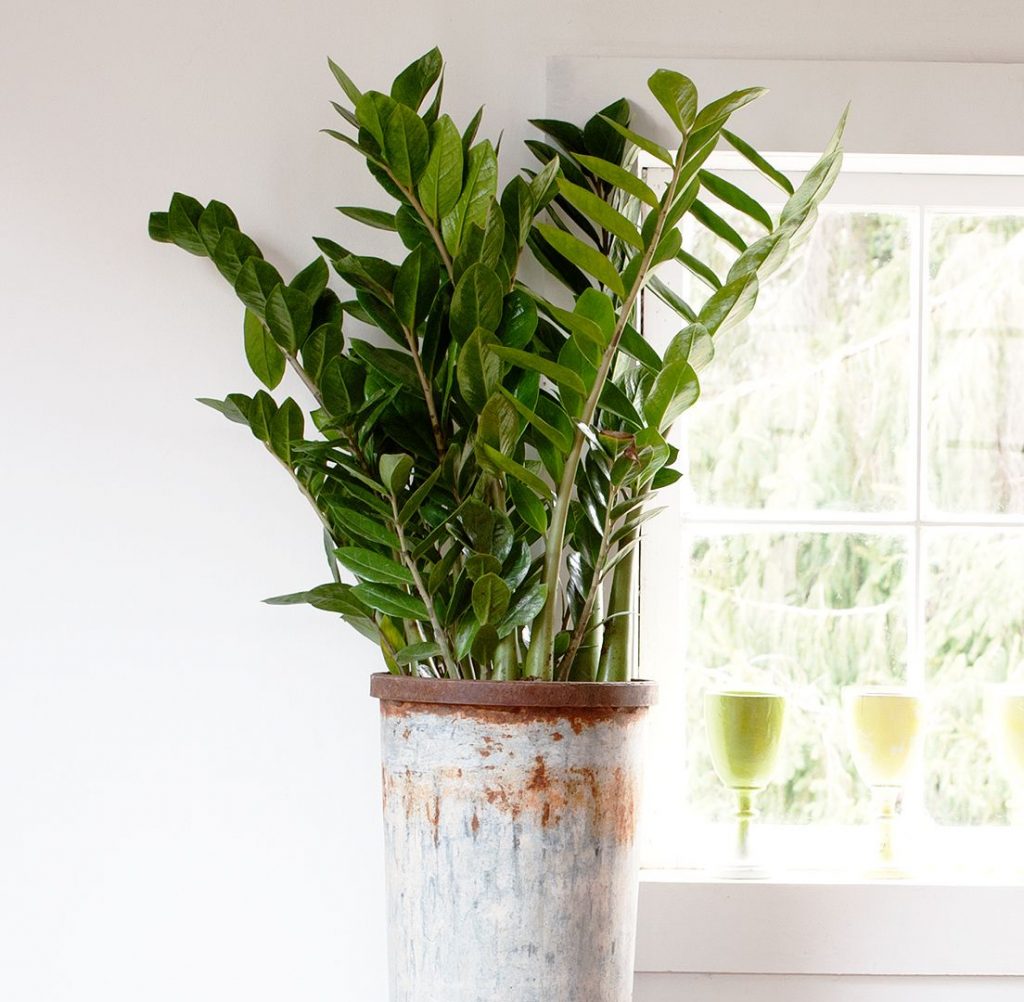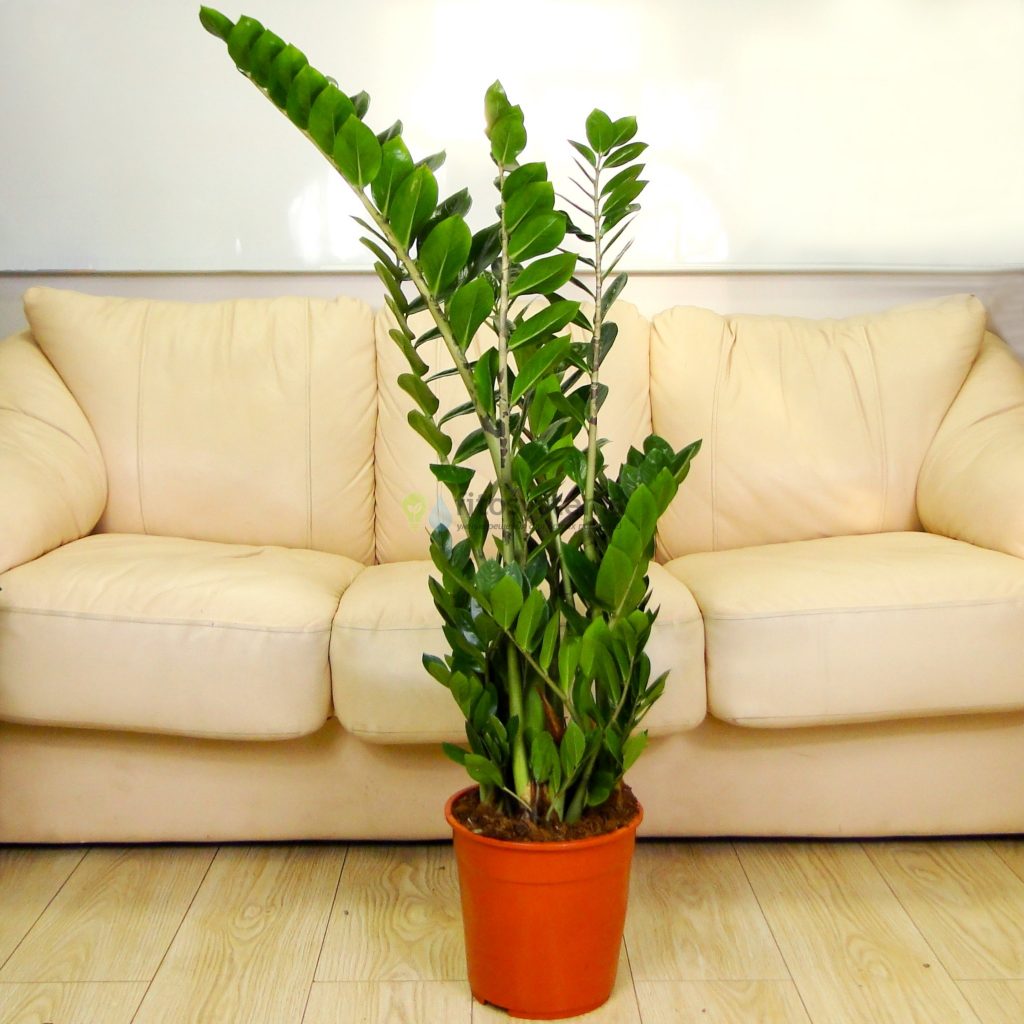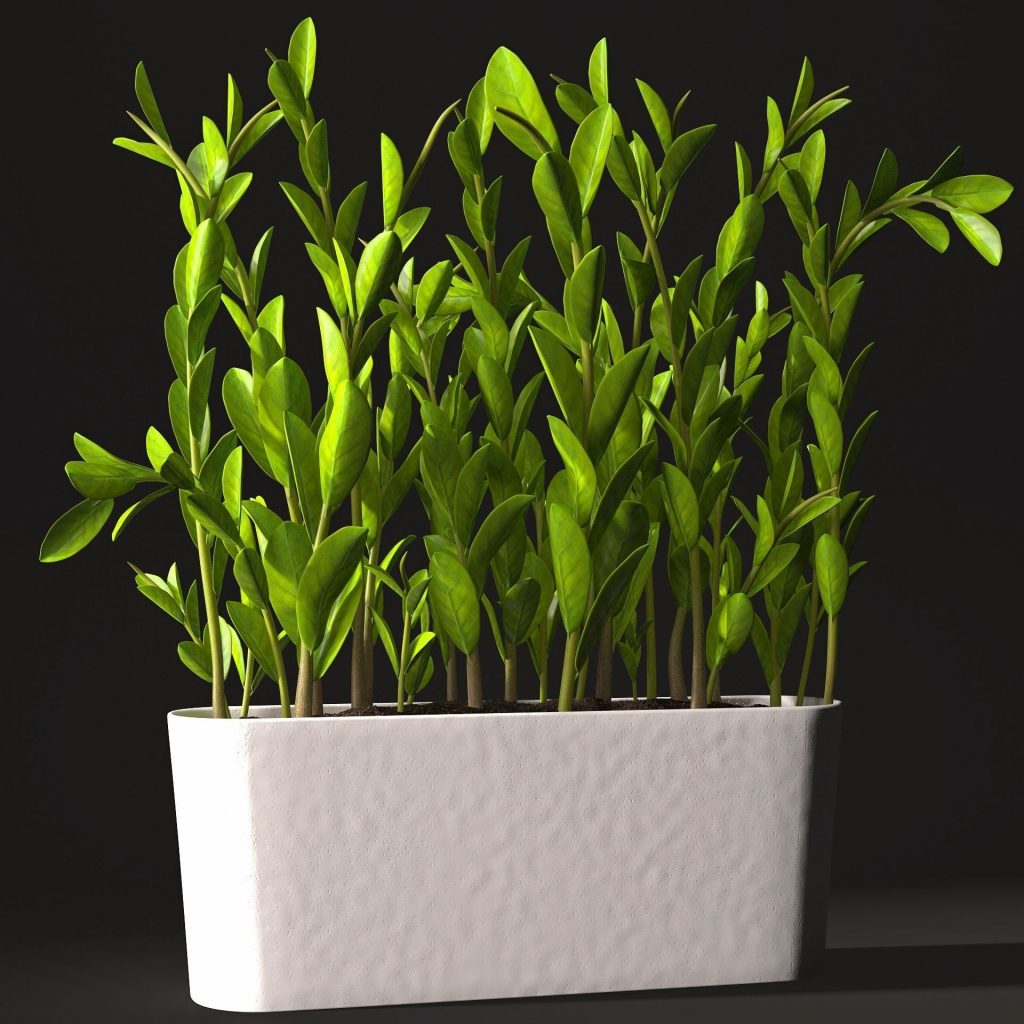Zamioculcas - rules of care, maintenance and reproduction at home
Decorative zamiokulkas - a bright representative of the Arodin family, is very popular in home floriculture. Country of origin - South Africa. Consider how the plant blooms and what kind of care it needs at home.
- general characteristics
- Benefit and harm
- Signs and superstitions
- Views
- Variegated (Variegated)
- The black
- Lanceolate
- Boivin
- Zamicro
- Zamielistny
- Purchase and adaptation
- Landing rules
- Growing conditions
- Humidity
- Lighting
- Temperature
- Care features
- Watering
- Top dressing
- Pruning
- Transfer
- Reproduction methods
- Tuber division
- Cuttings
- Sheet
- Twig (stem)
- Diseases and pests
- Useful videos

Zamioculcas photo flower
general characteristics
Zamioculcas - indoor flower, is a representative of the Aroid family. The botanical name is zamioculcas. The people call the dollar, or currency, tree.
Outwardly, it looks like a bastard (money tree), although the difference between them is significant - the first type is much larger, the leaves are oval with a pointed tip, flat and with a glossy surface, more reminiscent of the foliage of the zamia. In the fat woman, the leaf plate is matte, fleshy and round, the height of the shoots does not exceed 50 cm.
Features of the plant:
- has a large and massive underground rhizome tuber;
- stalks are thick, forming a basal rosette;
- leaves are dense, juicy, feathery, green or emerald tone, located on thick petioles closer to the top of the shoots, 6-7 cm long;
- flowering in indoor conditions is rare (even with good care);
- the inflorescences themselves are of no decorative value - they are white, light yellow or pale brown, usually developing in the lower part of the stem under the leaf;
- with age, it rarely releases new buds in the form of an ear or arrow with small pimples on the surface.
All parts of the plant contain a large amount of moisture, which helps it to survive drought more easily, especially in its homeland - in desert Africa.
Benefit and harm
The dollar tree has unique properties for the human body, so it is often advised to place it not only in apartments, offices, but also in hospitals and clinics. It purifies the air and is a kind of filter that prevents carbon from accumulating in small rooms.

Zamioculcas flower photo
According to Feng Shui, it is worth placing several copies at once in one room so that they have the maximum positive effect. Zamioculcas is useful for those who suffer from insomnia. To normalize sleep, it is placed at the head of the bed.
It is also useful to keep the plant in the nursery - it has a beneficial effect on performance, tones up and improves concentration.
Be careful! This is a poisonous flower, therefore, it is forbidden to eat the stems and leaves. When injured, they release juice that contains toxic substances. An adult may develop allergies, and a child or animals may develop severe intoxication.
Signs and superstitions
According to popular beliefs, blooming zamioculcas predicts female happiness.It is customary to give it to single girls and women who dream of getting married as soon as possible.
According to the teachings of Feng Shui, a flower without inflorescences is a sign of celibacy, so only a blooming copy is worth buying or giving.
There is another benefit of the plant - when placed in the left corner of the room, it will help bring prosperity and wealth into the house.
Views
For keeping in apartment conditions, several varieties have been bred, which differ in color, shape, height.

Zamioculcas photo how it blooms
After reviewing their names and brief descriptions, you can choose the most suitable variety for your home decor.
Variegated (Variegated)
Botanical name - Zamioculcas variegate. Homeland - about. Madagascar.
Huge zamioculcas - when grown indoors, it can reach 1.5 m in height and the same volume in diameter. This plant has a thinner and elongated leaf plate, on the surface there are shapeless spots of lemon shade.
Differs in a variegated color of leaves - on the surface of green leaves there may be white spots or stripes. In indoor conditions, it practically does not bloom.
The black
Botanical name - Zamioculcas black. The species was brought from Korea.
The stems are at first light green, in an adult tree they become dark, later turn black. The leaves are emerald, dense, with a glossy surface.
The plant looks very unusual, spectacular and bright, it will decorate any room.
Lanceolate
Herbaceous succulent, belongs to the Aroid family. The main difference between the species is the presence of feathery, lanceolate leaves along the entire length of the stems, saturated green with a glossy surface. This is a large species, the length of the sheet plate can reach 1 m.

How zamioculcas blooms
Boivin
The botanical name is Boivinii Decne, or gonatopus.
One of the most unusual species, which is widespread in the foothills and forest areas of East Africa.
Stems are greenish-yellow, erect, cylindrical, close to each other. At the top, rod-shaped inflorescences are formed, under each is a yellowish leaf.
Zamicro
One of the oldest species that appeared in 2007. It has a massive stem, the structure of the root system is tuberous.

Zamioculcas how it blooms
At the age of 5-6 years, from 3 to 5 shoots can develop on one flower, covered in the upper part with dense emerald leaves of an oval shape with sharp tips.
Zamielistny
The botanical name is zamioculcas zamiifolia. Among the people - loddijdes. The homeland of growth is South Africa, also found on about. Madagascar.
It has several varieties that differ in the shape and color of the leaves:
- Lucky White. A plant with massive, cylindrical shoots, on which are oval leaves with a pointed tip. The length of the leaf plate is 8-10 cm, the surface is smooth, light green with a white border at the end.
- Zenzi. The second name is curly dwarf. A low-growing plant no more than 60 cm in height with short internodes and a thickened stem in the lower part. The leaves begin to develop from the middle of the shoots. The length of the leaf plate is 8-9 cm, the color is dark green, the surface is glossy.
- Black Raven. The flower received this name due to the black color of the stems and leaves. The aerial part turns black as it grows; at the initial stage of development, the leaves are light green.
- Super Nova. Looks like a natural plant. Stems are fleshy, thick, rhizome in the form of a tuber. Zamiokulkas supernova leaves are dense, lanceolate, green, emerald in color with a blackish tint, formed from the middle of the shoots to the very top
Purchase and adaptation
You can buy such a flower at any flower shop. The price may vary depending on the size and grade - from about 300 to 600 rubles. Can be ordered online, where the cost is lower.
It is better to choose grown specimens with a well-developed root system. When buying such a flower, you should carefully examine the aboveground part.
In healthy zamioculcas:
- leaves and shoots are fresh, monochromatic, in variegated varieties they are multi-colored, but do not contain black, red or brown spots, blotches;
- stems without breaks, not sluggish, without signs of damage from diseases and pests;
- the substrate is moist, but without acidification and mold on the surface.
You can shake the crown slightly - if the leaves are crumbling, then the plant is sick with something and it is better to refuse it.
After the purchase, the tree is quarantined - kept in a separate room for three weeks. During this time, you can determine his condition - whether he has any diseases, parasites. In case of defeat, it is worth treating with pesticides, and only after that transfer to a common room with other vegetation.
Landing rules
It is necessary to plant in early spring before the beginning of the blooming of vegetative buds. For planting adults, large specimens, they use an outdoor ceramic or plastic flowerpot slightly larger in size for a tuber.

Zamioculcas flower photo flower
It is important that there are holes at the bottom for the outflow of excess moisture. The pot should be tall and not too wide.
First, a couple of handfuls of expanded clay or pebbles are poured, then up to half the volume of fertile soil. The tuber is lowered, all voids are filled to the top, crushed around the stem, moistened with warm water. After planting, the branches should be tied up so that the plant is stable.
Many growers place the pot in a flower pots or other decorative containers, which gives it a special decorative effect and originality.
Growing conditions
For growing, a purchased substrate is suitable, which is taken for growing succulents and cacti. If you wish, you can prepare the soil mixture yourself by mixing equal amounts of coarse sand, peat, turf and leafy soil.
The main thing is that the soil is light, loose, and allows air and moisture to pass through well.
When planting, it is necessary to use drainage, which will ensure the outflow of excess moisture. Usually they take pebbles or expanded clay.
You can put a flower on a window where there is diffused daylight. When grown on a southern windowsill, protection from scorching rays is required, since the leaves, trunk and young shoots can get burned. The money tree grows poorly in the shade - it develops slowly, the leaves turn pale, over time the entire aboveground part perishes.
Humidity
The leaves must be sprayed every two weeks. You can also arrange monthly lukewarm water showers. The soil is preliminarily covered with a film.
Such manipulations preserve the decorative effect of the flower and prevent the appearance of harmful insects.
Lighting
It is worth keeping a flower at home in the light, but without direct sunlight, otherwise the leaves will quickly burn, turn yellow and crumble. The optimal duration of the LED is 8 hours.
Placing a plant in the northern or eastern part of the house will make its leaves faint and stem growth stunted.
Temperature
It is a thermophilic perennial, in the spring-summer period the optimal regime is 20-27 ° С. In winter, the zamioculcas is moved to a cool place with a temperature in the range of 16-18 ° C. At lower rates, it freezes and dies.
It tolerates short-term summer heat well, but does not withstand sudden changes in autumn and winter. Therefore, at the time of airing the room, it is taken out to another room.
In summer, the flower should be placed on a balcony or loggia, in a place where there is protection from drafts, precipitation and scorching sunlight. It can be placed outside and kept until autumn, until the temperature drops to 16 ° C.
Care features
As a houseplant, flower growers began to grow zamioculcas not so long ago. It is suitable for interior decoration in an apartment, office, where the air is dry in winter.Under this condition, the plant lives in its natural environment.

Zamioculcas photo flower photo
Taking care of a flower is easy, so even a beginner can grow it. Some grooming secrets will help you successfully complete this process.
Watering
This plant needs regular, not frequent, but abundant watering. In spring and summer, once every two weeks.
The flooded zamioculcas begins to rot quickly, so it is important not to pour it over. The water accumulated in the pan is poured out. In the winter season, watering is less frequent than during the growing season - as the substrate dries to a depth of 4-5 cm.
After moistening, it is worthwhile to surface loosening the soil so that in the future it will allow moisture and oxygen to pass to the roots.
Many flower growers use special lechuza pots with a built-in automatic irrigation system. The advantage of such a flowerpot is that the plant is protected from overflow, moisture is supplied to the tubers as needed.
Top dressing
To achieve maximum decorative effect and good resistance to diseases and parasites, the plant needs to be fed. Use fertilizer for cacti and succulents. They begin to be applied in early spring and before autumn at intervals of 14 days.
In order for the bulb to quickly nourish nutrients, after each feeding, abundant watering is carried out.
You can also fertilize the aboveground part - use ready-made solutions (Epin, Zircon). They are needed to revitalize the stems and stimulate the growth of new shoots.
Pruning
This flower does not need shaping pruning - it develops shoots in different directions, forming a spreading crown. If you want to form a lush and thicker aerial part, it is worthwhile to slightly pinch the top. This will stimulate the development of new processes.
Throughout the year, it is worth cutting off non-viable organs - stems and leaves that have turned yellow, rotted, dried out, damaged by diseases, pests.
For this manipulation, take a sharp and sterile pruning shears, scissors to avoid infection.
Transfer
Purchased flowers need to be transplanted, since the substrate in which they were sold is not suitable for further cultivation. This procedure is started after three weeks in quarantine. Do not transplant during flowering as the plant will not survive stress and will die.
They take a pot 2-3 cm larger in the volume of the previous one, put expanded clay on the bottom, then a little nutritious soil mixture. The root is poured abundantly with water to facilitate the extraction procedure.After an hour, it is gently transferred from one container to another. If necessary, fill up the earth to fill all the voids, tamp, moisten.
Young zamioculcas needs a regular transplant - every two years. An adult specimen (over 6-7 years old) is not disturbed. For him, you just need to update the superficially old substrate with a fresh, fertile one.
Also, a plant is required to transplant, in which the root has rotted or has been damaged by diseases, pests. The flower is watered, removed from the flowerpot, the tuber is lowered into a basin of water to wash off the remnants of the soil. Dry, carefully inspect, cut the decayed places with a sharp knife. Then treat with fungicide, after drying, sprinkle with charcoal. The plant is transplanted into a new container with sterile soil mixture.
Reproduction methods
There are several ways to breed new indoor zamioculcas. Depending on the age of the plant, one or another method is used. It is not recommended to propagate a flowering specimen, you must wait until it fades.

Zamioculcas care zamioculcas
Tuber division
This method is suitable for older species that need to be rejuvenated. Aging can be called zamioculcas over 10 years old.
The correct dilution technique consists of several steps:
- water the flower abundantly, pull it out of the pot in an hour;
- immersed in a container of water to wash off the remaining substrate;
- dry, examine the root - for successful reproduction, it is important that it releases growth points (buds);
- all parts that have rotted must be cut off, since they are a source of infection;
- with a sharp and sterile knife, divide the tuber into several parts so that each has one growth point;
- the places of the cuts are sprinkled with activated or charcoal, dried in the fresh air for 2-3 hours;
- delenki are seated in a light and loose substrate of sod, leafy soil with the addition of perlite;
- the root is completely deepened to the first leaf, if planted too deep, the flower will begin to rot.
After planting, the plant is not watered for three days - moistening occurs due to the moisture that the tuber contains. After this time, standard flower care is required.
Cuttings
You can breed indoor zamiokulkas using cuttings. For this, an adult and healthy flower is suitable, which has grown greatly.
The stalk is cut from the stem, which is bare from below, if it has given at least one bud. It should not be too thin, the thicker the branch, the more chances of its survival.
Cutting is done with a sharp and sterile knife. The shoot is shortened to a length of 12-15 cm so that 2-3 leaves and one growth point remain on it.
Places of cuts are powdered with charcoal. Allow several hours to dry. You can plant in a plastic or ceramic pot with holes in the bottom filled with vermiculite. To speed up rooting, treat the lower part of the shoots with Kornevin before planting.
The cuttings should take a vertical position, therefore, after planting, props are installed next to them - a plastic support that is sold in a flower shop or a twig and tie a stem to it.
Sheet
You can get a large number of new plants at the same time with leaf plates. This is the simplest and most effective method used by many growers.
The leaves are separated from the stems, planted in a light and loose mixture of peat and sand (1: 1). You can germinate the leaves in a seedling box or plastic container. Planted at a distance of 5 cm from each other.
Planting slightly moistened, placed in a well-lit place. It can take several months for the root system to develop. To speed up the emergence of roots, you need a greenhouse. The leaves are covered with transparent film or glass.
Each sprout is planted separately after new leaves have grown on them.
Twig (stem)
This method is often applied to plants that have rotted, the root is falling apart and it is no longer possible to restore it. The whole branch is separated together with the leaves, sprinkled with crushed coal in the lower part, dried, planted in a loose and light substrate of turf, leafy earth and perlite. Watered on the third day.
Diseases and pests
Throughout the year, the dollar tree can be damaged by various parasites and infections, especially if the rules of maintenance and care are violated.
| Diseases and pests | Signs | Treatment methods | Preventive measures |
| Anthracnose | It is a fungal disease that damages stems and leaves. Dark spots of brown or black appear on them. Causes of infection - high humidity and heat | You can treat this sore with several drugs - colloidal sulfur, Bordeaux liquid or copper sulfate. All damaged parts must be trimmed before spraying. | Optimize humidity and temperature readings |
| Powdery mildew | White bloom in the form of flour on the leaves, stems is a clear sign of the appearance of a fungus. Over time, the infected organs die off. | Spray the crown and soil with Quick or Topaz | Reduce the frequency of watering, lower the temperature regime |
| Sooty (black) mushroom | Precursors of the appearance of fungi - aphids, whiteflies and mealybugs | First, they are treated with insecticides from pests.After treatment, each leaf and the surface of the stems are washed with a solution of household soap (40 g per 1 liter of water). | Spray the crown regularly with warm water, inspect for damage by harmful insects |
| Gray, root rot | The main reasons for the appearance are frequent overflows with cold water, growing in heavy and acidic soil. First, the tuber rots, then the infection spreads to the underside of the stem - it withers, wrinkles, the leaves turn yellow and fall en masse | It is possible to save such a specimen at the initial stage of infection, when slight rotting of the root is noted. It is removed, washed from the soil, cut out all the affected parts, treated with fungicides, dried, planted in a new container with a sterile substrate. It is impossible to reanimate zamioculcas, whose root system has completely rotted. Take a couple of stems for propagation, the mother flower is disposed of | Adjust watering, use room temperature water |
| Mealybug | When this parasite appears, the leaves wrinkle, become covered with a white, sticky bloom, reminiscent of cotton wool | Shriveled leaves are cut off, burned. The crown is sprayed with Intavir, Fitoverm or Aktellik | Wash once a month with soapy water (40 g per 1 liter of water) |
| Thrips | The stem wrinkled and a white bloom appeared on the leaves - a sure sign of infection with thrips. | For the duration of the treatment, the flower is transferred to another room. They are treated with Karbofos or Intavir | Observe the watering scheme, provide good illumination, remove the organs damaged by parasites in time |
| Shield | Reddish plaques appear on the stem, leaves, feed on their sap, as a result, they become covered with black spots. The plant turns yellow and dries | First, remove all parasites by hand using a cotton swab. Then the soil and crown are sprayed with Aktellik or Decis twice with an interval of 7 days | Use fresh and sterile soil for planting, transplanting, regularly inspect for damage in spring and summer |
| Root mealybug | You can determine that worms have started up in the ground by the general condition of the aboveground part - it begins to fade, the stems and leaves are deformed, turn yellow and die off | So that such a flower does not completely dry out, it must be dug out, the tuber should be washed from the soil, and immersed in a fungicide solution for 2 hours. Dry, transplant into a new pot with disinfected soil | Use only fresh and sterile planting substrate, avoid overfilling |
| Whitefly | The small white moth does not harm the plant, but its offspring are caterpillars, they love to feast on the tissues of young leaves and buds. The worn out places darken, die away | All affected organs are cut off, the aerial part is treated with a solution of dusty soap, which is sold in a pharmacy | Plant and transplant into sterile soil, periodically inspect for the appearance of butterflies |

